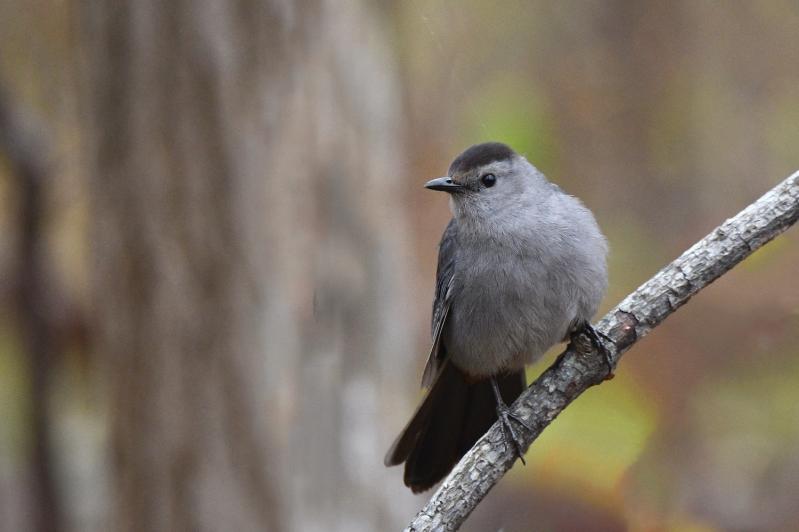At 4:11 a.m. Monday, a catbird, probably the same catbird that has been visiting my feeder where I offer it cut fruit and suet, began to sing. Does any creature look forward to the sunrise as eagerly? Mary Oliver wrote of the catbird, "In his whole life he has never missed the rising of the sun."
While some birds are celebrated for their plumage, their melodic songs, their rarity, or their beautiful habitats, the catbird has none of these. Depending on what you're looking for, it might be a dull bird, almost uniformly dark gray, with just a black yarmulke and rust-colored undertail covert to break up its otherwise monochromatic look. It's even named after another animal.
It's neither rare nor shy. If you have one in your backyard, you likely know. In fact, James Thurber wrote a short story in 1942 called "The Catbird Seat," and that phrase came to mean a position of great prominence, because often catbirds sing from conspicuous perches. Its habitat isn't conventionally attractive. It likes dense tangle, green mazes.
So, we are left with its perplexing song. What's it saying? Catbirds are named for their mewing, whiny call, which resembles a cat's meow. But that's just one of a seemingly infinite number of sounds that are released when this bird opens its black bill. There are no easy words to put to this song. It starts and stops, it's anti-melodic, a slow tangential shamble. It shoots off in different directions all at once. I imagine something like it plays in the head of Elaine, from "Seinfeld," when she dances. To quote Mary Oliver further, she says in her poem named after the bird that it "makes up his song as he goes."
When was the last time you had a completely new thought, or broke out of your well-established patterns? I hear the catbird and I sense it reaching for something. Is it trying to describe the last bits of darkness before the first glow of light each morning? Is it searching for a song?
Another thing about the catbird that sets it apart is its inquisitive nature. Work in your garden and you may soon have a catbird working alongside you. They're charming, excellent company.
Catbirds migrate, but not far like the warblers or some of our shorebirds. Most stay in the Southern United States, and some hardy individuals even remain on Long Island. They eat insects, so this is another bird you don't want to starve by spraying your property with pesticides. They love ants, midges, beetles, and moths.
It's easy to spot this bird in May and June when they are breeding. Here's a bird that exemplifies the idea that everything is habitat. I've worried about catbirds as I've watched my neighborhood get cleared of brush these last few years. The tangles and dense bushes that some find ugly, or inconvenient, are home to these personable birds. They need that stuff.
If you're not lucky enough to hear one singing in your yard at dawn, there are many local spots to see the catbird. I had at least 20 at Sayre Park in Bridgehampton last week and more than 30 at Montauk's Camp Hero. Dozens are now singing at the Elizabeth A. Morton National Wildlife Refuge in Noyac.
But if you have one in your yard, wake up early and go listen to it sing in the dark. It'll tell you about life. It's not melodic, and it can be a bit chaotic. But there's a song in there somewhere.
Bird Blotter
The bulk of songbird migration will end in the next week or so. Blackpoll warblers and Eastern pewees have begun showing up, and pollen is filling the air. This means the end is nigh. But we had some great sightings this week.
Pamela Abrahams has lived in Northwest Woods for over 40 years, and for the first time she had a rose-breasted grosbeak visit her feeder. She said it ate "nimbly and casually" before departing after a couple of days.
Nancy and Bill Nagle live close to East Hampton Village and were lucky enough to have two male indigo buntings eat hulled sunflower seeds from their feeder between May 9 and Friday. Ms. Nagle said they were "stunningly vibrant" and came right to her window feeder, affording great looks.
May 14 was eBird Global Big Day, and along with my daughter Miachesca and my friends Evan Schumann and Bruce Horwith, we were able to find 75 species of birds, mostly in Sag Harbor. We had eight species of warbler: blue-winged, American redstart, yellow, prairie, Tennessee, yellow-rumped, common yellowthroat, and ovenbird. Indigo buntings are setting up nests at the South Fork Natural History Museum, white-eyed vireos at Sagg Swamp, and scarlet tanagers at Crooked Pond.
A wood thrush has been singing the last two days from my North Haven yard. Go to YouTube and listen to the song. It's beautiful.
Finally, shorebirds and terns are beginning to move through. Steve Biasetti counted 30 ruddy turnstones up at Maidstone Park, a couple of roseate terns, and two American oystercatchers.
Time to start looking for nests and fledglings. Please keep your cats indoors, your dogs on a leash, and send sightings to [email protected].

